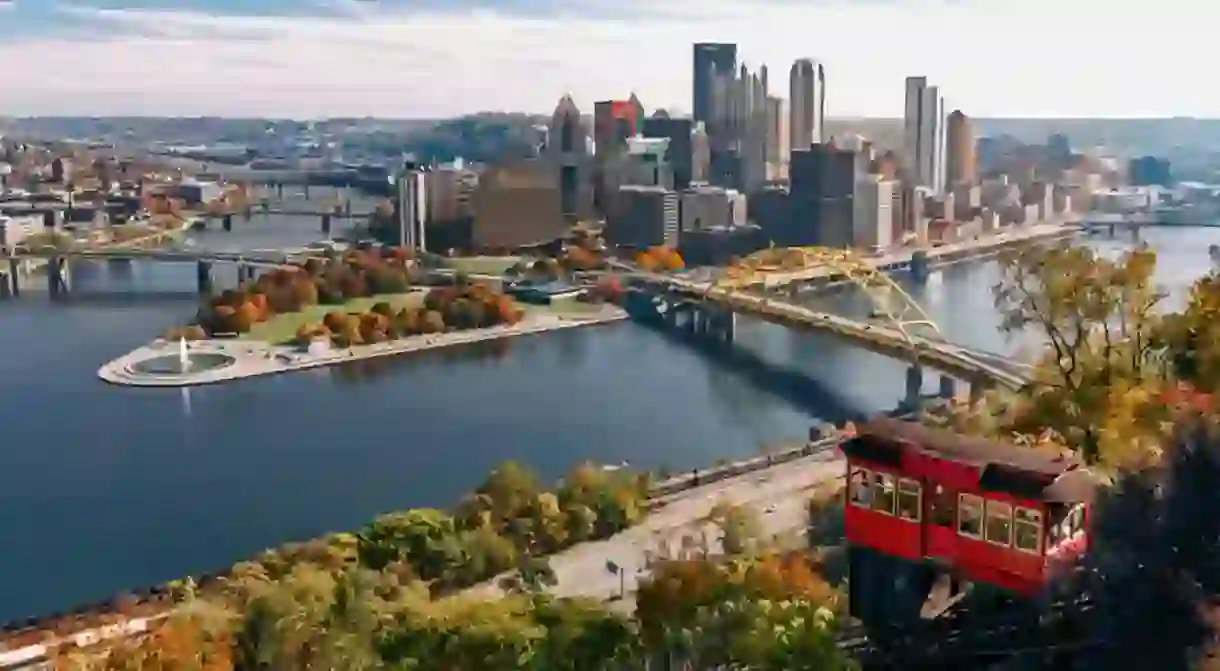The Best Things to Do in Pittsburgh, USA

Sponsored by

Pittsburgh isn’t short on year-round attractions and curiosities. From visiting a famous dinosaur to exploring the city’s superb museums, this affordable destination is full of unexpected attractions around every corner. Read on for our pick of the best things to see and do only in Pittsburgh.
Ride the Duquesne Incline
For unbeatable views of Pittsburgh, as well as access to the stylish Mount Washington neighbourhood, take a ride on the Duquesne Incline. Opened in 1877, it was restored by a local collective in the late 1960s and still features the two original wooden cable cars. It runs 365 days a year between the Lower and Upper Stations, the latter of which has an observation deck with views across the city and a museum exploring the history of Pittsburgh and the incline itself. Visitors can also watch the incline’s machinery operate while the cars are in motion.
Explore the Strip District
The Strip District runs along the eastern banks of the Allegheny River between 11th and 33rd Streets, and was once an industrial landscape of mills and warehouses. Nowadays, it’s one of the best areas of Pittsburgh for eating, drinking and shopping. Foodies will love the Strip’s profusion of international grocery stores – from Polish and Middle Eastern to Mexican and Asian – and top-notch restaurants such as Kaya, where star dishes include the burger and the Cuban sandwich. Another of the area’s key attractions is the Heinz History Center, where you can learn more about Pittsburgh’s past.

Visit the Andy Warhol Museum
Pittsburgh is home to the world’s largest collection of works by Andy Warhol, the city’s most famous artist and one of the pioneers of the 1960s’ Pop Art movement. The Andy Warhol Museum was opened in 1994, within a packing warehouse dating from the early 20th century. Spread over seven spacious floors, the permanent collection showcases the artist’s paintings, prints, sculptures, photographs, drawings and commercial projects, as well as his entire video output, comprising more than 4,000 videotapes. The Factory education studio, located in the basement, hosts events and classes.
Explore Point State Park
The 36-acre (15ha) Point State Park occupies the tip of the Golden Triangle, at the confluence of the Ohio, Allegheny and Monongahela Rivers. As well as providing a tranquil spot in which to escape the city and admire one of the country’s largest fountains (the water is thrown 150ft (46m) into the air), it’s also home to Fort Pitt Block House, the only remaining part of Fort Pitt. Built by British forces between 1759 and 1761, this was a key fortification during the French and Indian War of 1754-63, a conflict that’s explored in detail at the park’s Fort Pitt Museum.

Embark on a foodie adventure
The culinary scene in Pittsburgh is ripe for exploring, with its unique variety of neighbourhoods and range of cultural influences throwing up all kinds of different foodie experiences. The best way to discover them is on a ‘Burgh Bits & Bites walking tour. This team of passionate locals have been running tasty tours of the city for just over 15 years now, and you can choose from a variety of neighbourhood-specific tours, or even book yourself a custom itinerary. Gobble down Italian pastries and cinnamon buns in the Strip District, explore the blue-collar roots of Lawrenceville’s hip food scene or head to South Side for empanadas, tacos and donuts.
Explore the Cathedral of Learning
Towering 535ft (163m) above the University of Pennsylvania’s campus, the aptly-named Cathedral of Learning is the second-tallest university structure in the world, falling short only to Moscow State University’s main building. Built between 1926 and 1934, this 42-story Gothic Revival skyscraper houses a three-story high Common Room and 29 Nationality Classrooms, each of which are themed around a country that has contributed to the growth and development of Pittsburgh. Other working university facilities within include a library, computer rooms, a theatre, offices and a food court.
Visit the Phipps Conservatory and Botanical Gardens
Located in Schenley Park, the Phipps Conservatory and Botanical Gardens is one of the oldest and largest such buildings in the States. Bequeathed to the city in 1893 by steel and property magnate Henry Phipps, this 15-acre (6ha) site comprises the original, 14-room Victorian glasshouse, in which exotic flora such as bonsai, orchids and succulents are displayed across 23 distinct gardens. The largest of these is the Tropical Forest Conservatory, which recreates a new region every three years. Phipps also offers a range of interactive experiences for kids, a gift shop and a café.

Visit Heinz History Center
Pennsylvania’s largest history museum is part of the wider Smithsonian collection and serves as an archive of all things related to the state. Highlights include the world’s oldest jeep and one of the original sets from Mister Rogers’ Neighborhood, which should tell you something about the broad appeal of the place. The six floors include interactive experiences that you’ll want to spend time exploring, so its worth planning your trip here in advance.
Take a stroll in Beechview-Seldom Seen Greenway
For some off-piste exploring, head to the 100-acre (40ha) Beechview-Seldom Seen Greenway, an almost-forgotten natural area located between the Mount Washington and Beechview neighborhoods. The path along which you can walk and cycle features a colorfully spray-painted railroad crossing and an unusually-constructed stone bridge dating from the early 20th century. You can also bathe off the rocks in the summer, picnic in one of its many shaded spots and, when the water level permits, walk along the creek itself.












